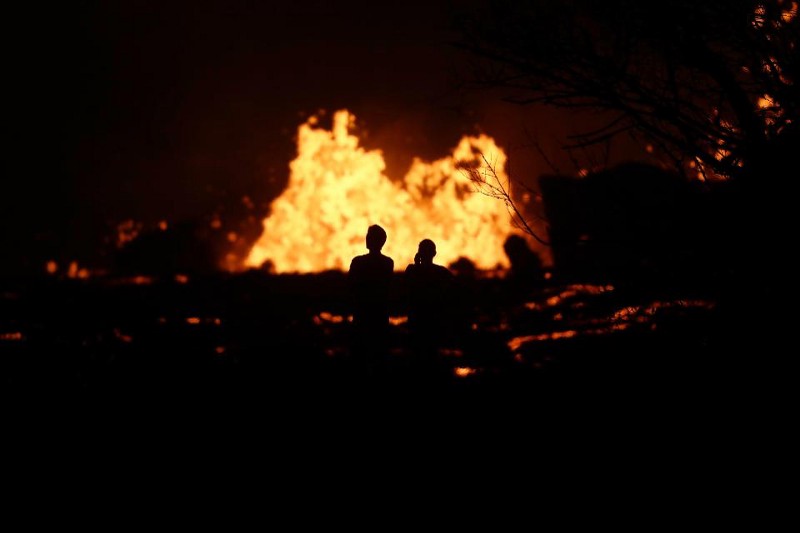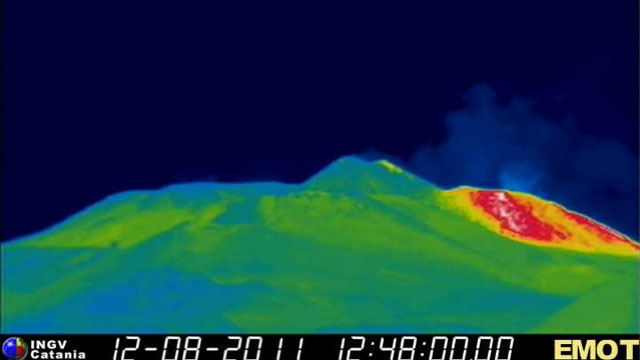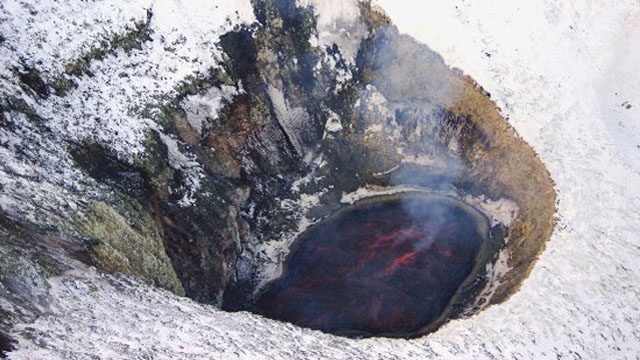GVP’s Sally Kuhn Sennert answers your questions!
Earlier this summer, we had a chance to ask Sally Kuhn Sennert of the Smithsonian Institution/USGS Global Volcanism Program questions about her job as the main writer of the well-loved Weekly Volcanic Activity Report. Well, now here are the answers!
nn
nSally Kuhn Sennert of the Global Volcanism Program in front of Mt. Rainier, Washington.
nn
Q&A; Sally Kuhn Sennert:
nn
Q: Could you describe how you go about putting together the weekly update?
nA: If time permits, I would start to gather information on Friday when particular sources post their weekly summaries. The majority of the information gathering, however, actually happens on Monday mornings, when I visit about 40 websites. I also rely on reports coming to me via email either directly from the source (like from Rabaul Volcano Observatory) or indirectly through news feeds. I read the source information and write reports for most of Monday and Tuesday, often revisiting sites for updated information in the process. On Wednesday morning, I check a few more sites and then pass the “finished” Weekly Report to colleagues. The Report then goes through two rounds of editing by two of three regular Weekly Report editors in the Global Volcanism Program. In the meantime, I prepare the website files, such as the interactive map. If everything goes smoothly, the Report should be posted around 4 PM on any given Wednesday! Whew!
nn
Q: How do you differentiate between reliable and unreliable sources?
nA: I consider THE authority to be the folks at individual observatories and therefore the reports they produce. I also utilize the notices from the multiple Volcanic Ash Advisory Centers (VAACS). News reports are also important, especially when there are no other sources. With the media, I try to only use major sources, such as Reuters or Associated Press, and I use them carefully! Once in a while, one of the sources gets something wrong (analysts initially thought plume seen in satellite imagery was from volcano- later discovered it was from forest fire) or I misinterpret a translation, and a correction has to be posted in the report. That is the nature of the “rapid reporting” of the Weekly.
nn
Q: Do you get a lot of “tips” from people about volcanic activity that is happening?
nA: Funny thing about that- on a few occasions now, I have learned about eruptions I had no clue about from my grandma or mom!! In my defense, they are events that happened on weekends, when I am tuned out. Yeah, that’s my story.
n
nQ: What would make your job easier in terms of getting a complete picture of activity?
nA: Definitely visiting more volcanoes!! It is so much easier getting the big picture of an event if you have been there and know the layout of the land or have seen the previous eruption products first hand. I would also love to meet more volcanologists (esp. folks at the observatories) around the world. Familiarity with people you communicate with is so important.
nn
Q: How do you see the reports changing in the future? What about the GVP in general?
nA: As the world becomes more digital, GVP has lost some of the personal connections with contacts that have really strengthened the monthly Bulletin, the database of activity, and to some degree the Weekly in the past. People used to call in or fax information, but now, observers can just post reports on their own blogs or websites! We are in the process of really reconnecting with people and fostering better information exchange. We are also continuing to improve our website and how we communicate to reach as many people as possible. For the Weekly specifically, I would love to see better maps available for each volcano- perhaps something 3-D and interactive.
nn
Q: Have any new social networking sites like Facebook or Twitter made your job easier or harder?
nA: Both! It is important to keep up with the current communication technology and methods; if you want to get your information out there, you have to do it in the way your audience prefers. The downside is that I can’t keep up! My grandma and I share this complaint.
n
nQ: What sort of questions do you get at the GVP from the general public? How about the media?
nA: Public questions vary depending on the interests of the individual asking the question. GVP recently participated in the Smithsonian’s Folk Life festival and showcased what we did. Questions from the public varied from why the “African Plate” is named the Nubia Plate to what was the magnitude of an earthquake that happened in the questioner’s hometown on the day they were born. Questions like these, and seeing the wonder on people’s faces when you talk about volcanoes or geology in any form, make it all worth it. Most of the questions from the media come during an eruption and center on trying to get us to predict when it will stop. Enthusiastic reporters are always fun to talk to, no matter what they try to make you say!
n
nQ: Is there any way the general public can get involved with helping the GVP, the weekly reports or the website?
nA: YES! GVP hosts several volunteers that work on the Bulletin reports, if you’re interested drop me an email. We also welcome reports of volcanic activity from anyone that will send them, either volcanologists doing fieldwork or the casual vacationing observer. We do need specific information to incorporate the information into a report, such as date of observation or where the observer was. The more info the better! Many of our reports of volcanic activity “in the middle of nowhere” come from a recreational sailor passing by or a hiker on an adventure. I often ask, if a volcano in the ocean erupts and no one is there to see it happen, did it? A later random floating pumice raft may have the answer.
nn
Q: What volcanic event of the last few years was the most interesting to follow?
nA: The eruptions that stand out in my mind are from Jebel at Tair (2007), Nevado del Huila (2007), Kelut’s dome growth (2007), Chaitén (2008), Sarychev Peak (2009), and finally the 2010 Eyjafjallajökull eruption. All of these events were new, exciting, important, and fun to follow.
nn
Q: What else do you do for the Global Volcanism Program and/or the Smithsonian Institute/USGS?
nA: My current high-priority “other project” is to write film scripts. I am helping my Global Volcanism Program colleagues create short educational films based on our historic film footage archive that we are currently digitizing. Several will be available on-line very soon, and in multiple languages.
n
nQ: What is your favorite volcano?
nA: I have to pick only one? That is tough! My default favorite (from grad school days) is Popocatépetl, specifically because of the fabulous existence of “Popo Cam”, but when I really think about it, I have to say Kilauea. It is such an interesting and accessible volcano! People from all walks of life, all ages, all backgrounds and interests can go there, hopefully at the right time, and have an experience of a lifetime. I lucked out when I participated in a field school and got to stand on cooled lava flows while watching (and feeling the heat of) new Earth being born right in front of me. I will never forget my time there, and probably never again eat a burrito as good as the one I cooked on an incandescent crack.
nn
Q: How do you determine which volcanoes are listed in the active category versus the ongoing category (each week)? (From Diane; Stephen in the UK)
nA: There is a page called “Criteria and Disclaimers” that discusses the topic of your question (http://www.volcano.si.edu/reports/usgs/index.cfm?content=disclaimers). Even though the reasoning behind the category assignment seems straight-forward, there are some volcanoes or some eruptions that don’t quite fit the mold. So I sometimes consider the assignment on a case-by-case basis. For instance, I reported seismic swarms (no eruption) at Melimoyu in mid-June 2010. That volcano has never been reported on in the Weekly or the Bulletin, as it has only two documented eruptions in the Holocene. I assigned it to the “New Activity/Unrest” section to draw attention to it simply because it has not been reported on before. There are other volcanoes that have periodic or “typical” seismic swarms that I don’t include in the weekly at all.
n
nQ: Why are there sometimes unfinished or outdated information on the Global Volcanism Program website? (from Jon Friman)
nA: The only area that may seem “unfinished” that I can think of is the Geologic Summaries written for each volcano. They are occasionally written in a way that does not accommodate new activity, and need to be re-worded. They, along with some other areas of the website, get updated yearly. As far as “outdated,” one of the main goals of GVP is to database and archive information about volcanic activity over the last 10,000 years. We are currently archiving data from volcanoes active in the Miocene as well. So, by design the archived information is “outdated!”
nSeriously, if you see something on the website that seems incorrect, unfinished, or just leaves you scratching your head, please email me and I will certainly look into it.
n
nQ: Why was the recent large eruption at Redoubt 2008-2009 removed from the list of larger Holocene eruptions? (from Riggs)
nA: I am not aware that it was there and removed. The list of large Holocene eruptions consists of volcanoes with VEI eruptions classified as 4 or higher. Perhaps the Redoubt eruption in question was thought to have been a 4 or higher at first and then changed to a 3 once the activity and products were better understood.




